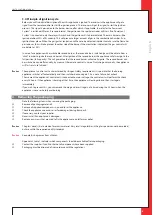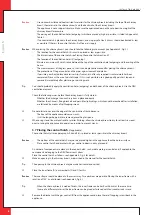
English
I NST AL L AT ION MAN U A L
!Caution
•
Use non combustible and heat-resistant materials for the chimney breast including the top of the chimney
breast, the material in the chimney breast and the back wall of the chimney breast.
•
The appliance is not a support structure. Make sure the appliance does not have to bear the weight of the
chimney breast for example.
•
The passage of the ventilation holes (outgoing), which are placed as high as possible, is stated in Appendix 2,
Table 2.
•
If no control hatch is placed in the chimney breast, an air supply of at least 80 cm
2
should be attached as low
as possible. If there is, the control hatch will suffice as air supply.
!Caution
When placing the chimney breast, you should take the following into account (see Appendix 3, Fig. 2):
•
The location for the control hatch: this must be placed as low as possible.
•
The dimensions of the control hatch; see Placing the control hatch section 5.7.
•
The location of the ventilation holes (V) (outgoing).
•
Maintain a minimum 30 cm distance between the top of the ventilation hole (outgoing) and the ceiling of the
house.
•
The measurements of the glass pane, so that it can be placed/removed after placing the chimney breast.
•
The protection of the gas control and the pipes against cement and plaster.
•
If possible, you should place decorative strips, frames, etc., after any required structural work has been
completed. Prevent the use of painter's tape. If this is not possible: use a good quality painter's tape and
remove it immediately after plastering or painting work.
!Tip
You should preferably apply the ventilation holes (outgoing) on both sides of the chimney breast. Use the DRU
ventilation elements.
Check the following issues, before the chimney breast is fully closed:
•
Whether the discharge / concentric system is placed correctly.
•
Whether the channels, fixing brackets and possible clip bindings, which cannot be reached after installation,
are fastened by means of self-tapping screws.
Ø
Do not plaster on or over the edges of the construction frame, because:
•
The heat of the appliance could cause cracks.
•
It will no longer be possible to remove/place the glass pane.
Ø
When using stone-like materials and/or plaster finishing, allow the chimney breast to dry for at least six weeks
prior to taking the appliance into operation in order to prevent cracks.
5.7 Placing the control hatch
(if applicable)
The control hatch (also see paragraphs 5.5 and 5.6) is placed as low as possible in the chimney breast.
!Caution
•
The bottom of the control hatch may not be placed higher in the appliance than the burner surface.
•
Place control hatch and bracket with gas control indoors in a dry place only!
A number of components are placed in the control hatch, such as data plate, gas control and, if applicable, the
components belonging to the DRU Powervent System
®
.
Place the control hatch as follows, see Appendix 3, Fig. 3 for details:
Ø
Make an opening in the chimney breast, as described in the manual for the control hatch.
!Tip
The opening in the chimney breast may be made horizontal and vertical.
Ø
Place the inner frame (A); unscrew bolts (D and F) for this.
!Caution
The inner frame should be placed in the correct way. Two positions are possible. Placing the inner frame with a
rotation of 180° is not allowed (see Appendix 3, fig. 4).
!Tip
•
When the chimney breast is made of bricks, the inner frame can be built with bricks at the same time.
•
In case of a different material, the inner frame can be glued or fastened with four countersunk screws.
Ø
Remove the bracket with the gas control (B) from the appliance and place these self-tapping screws back in the
appliance.
8
Summary of Contents for Metro 130XT-2 RCH
Page 30: ...E n g l i s h INSTALLATION MANUAL 30 B H D G F E A C 38C 1747 0 38C 1868 d 0 4 3...
Page 31: ...E n g l i s h INSTALLATION MANUAL 31 A 2 B 3 38C 1956 0 4 1 0 8 4m 0 5m 38c 744zi 1x90 6 5...
Page 32: ...E n g l i s h INSTALLATION MANUAL 32 A 1 C 2 D 3 B 4 E 5 6 38c 1957 S T 38c 1664 0 R U 8 7...
Page 33: ...E n g l i s h INSTALLATION MANUAL 33 38C 1620 0 8x L L 1 2 2 55 40 38C 1662 0 10a 9...
Page 34: ...E n g l i s h INSTALLATION MANUAL 34 38P 0263 38P 0432 38P 0433 38P 0434 11 12 13 14...
Page 36: ...E n g l i s h INSTALLATION MANUAL 36 38p 0443 38P 0442 A C B E 38p 0444 D 19 20 21...
Page 37: ...E n g l i s h INSTALLATION MANUAL 37 F G H 38P 0445 38P 0446 38P 0447 22 23 24...
Page 38: ...E n g l i s h INSTALLATION MANUAL 38 38p 0486 38p 0487 25 26...
Page 42: ...E n g l i s h INSTALLATION MANUAL 42...









































